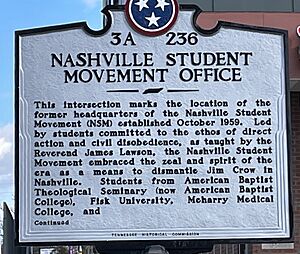Nashville Student Movement facts for kids

Location of former headquarters of the Nashville Student Movement
|
|
| Abbreviation | NSM |
|---|---|
| Founded at | Nashville, Tennessee |
| Purpose | To challenge segregation in Nashville's public accommodations |
| Location | |
| Methods | Nonviolence |
| Leader | James Lawson |
|
Strategist
|
James Bevel and Diane Nash |
The Nashville Student Movement was a group of young people. They worked to end racial segregation in Nashville, Tennessee. This happened during the Civil Rights Movement in the United States. Segregation meant that Black and white people were kept separate in many public places.
This movement started with special lessons on nonviolence. These lessons were taught by a leader named James Lawson. The students from this group began the famous Nashville sit-ins in 1960. They were known for being very organized and effective. The Nashville Student Movement also helped lead the Freedom Riders.
Many important Civil Rights leaders came from this group. They helped create strategies for the movement in the 1960s. Some of these leaders included Diane Nash, Bernard Lafayette, James Bevel, John Lewis, C. T. Vivian, and Jim Zwerg.
The students often dressed nicely during their protests. They did this because they expected to be arrested.
Even famous leaders like Martin Luther King Jr. admired the Nashville Student Movement. King praised their amazing organization and discipline. The movement used peaceful methods, inspired by Mahatma Gandhi. These methods helped the Civil Rights Movement succeed. Their nonviolent actions helped their message spread widely.
One big success was ending segregation in Nashville. This made Nashville a leader in desegregation for other American cities. Lawson was a key mentor. He used his knowledge of nonviolence to help young people fight unfair Jim Crow laws peacefully.
How the Movement Started
Nashville was an important place for civil rights actions. This was because segregation and unfair treatment continued there. The Southern states were known for racism and white supremacy. Most people there were white, and Black people faced discrimination.
Within Nashville, there were four colleges for Black students. Today, these are called HBCUs (Historically Black Colleges and Universities). Students from these colleges faced discrimination every day. Many decided to unite and fight for their rights.
These students joined with Reverend James Lawson (activist). He taught them about nonviolence. Many of these lessons took place at Clark Memorial United Methodist Church. One participant said, "Clark was the birthplace of the civil rights movement in Nashville."
The Nashville Sit-ins
The students began their peaceful protests called "sit-ins." They would sit at segregated lunch counters. On February 27, 1960, 82 activists were arrested during a sit-in. They were all tried in court on the same day.
Out of the 82 people arrested, 77 were Black students and five were white students. The court gave them a choice: go to jail or pay a fine. The students chose jail. This showed how serious they were about their cause.
Even after important events like Brown v. Board of Education, segregation continued. The Nashville Student Movement used peaceful protests. They wanted to end legal segregation in the South.
Lasting Impact
The story of the Nashville students is told in a 1999 book. It is called The Children by David Halberstam. This book shares the experiences of the students and their actions.
The start of the Nashville Student Movement is also shown in a graphic novel. It is John Lewis's 2013 book March: Book One. There is also an animated series based on it.
A special marker honors the movement. It is called the "Nashville Student Movement Office." It is located at 21st Avenue North and Jefferson Street. This marker remembers the civil rights protests in Nashville.
Nashville and Tennessee officials want to make the civil rights movement a tourist attraction. In 2018, six Nashville locations became part of the United States Civil Rights Trail. This trail connects different Civil Rights sites across Southern states.
See also

